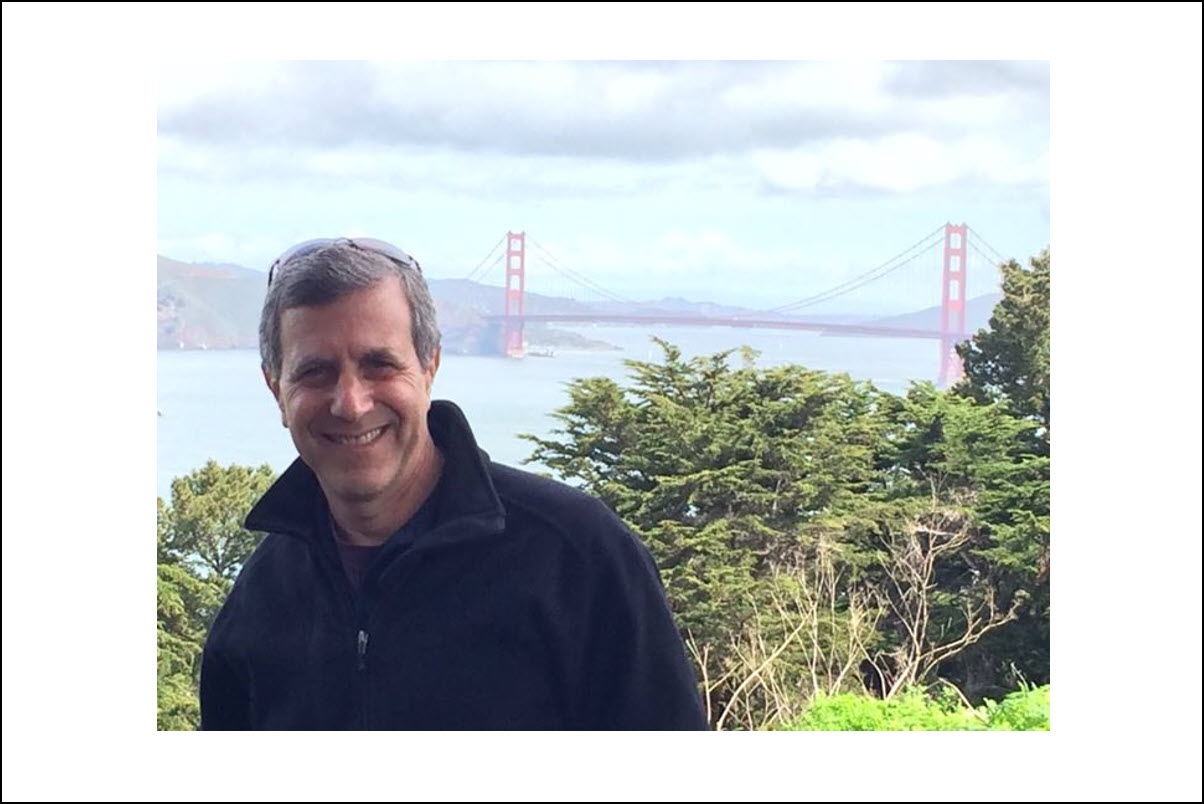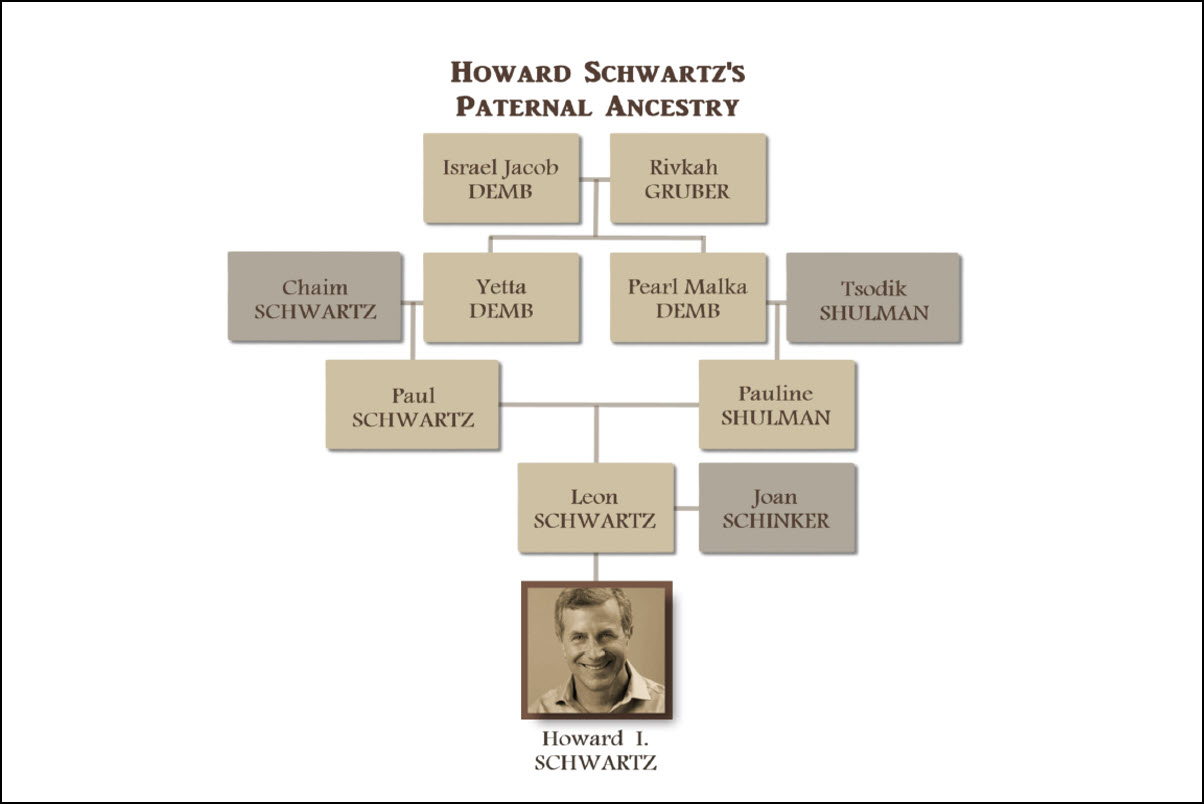-
Home
Home About Network
- History
Nostalgia and Memory The Polish Period I The Russian Period I WWI Interwar Poland WWII | Shoah 1944 Memorial Commemoration- People
Famous Descendants Families from Mlynov Migration of a Shtetl Ancestors By Birthdates- Memories
Interviews Memories 1935 Home Movie in Mlynov 1944 Memorial Commemoration Commemoration Wall- Other Resources

Mlynov descendant, Howard I. Schwartz, PhD
My name is Howard Schwartz (formerly Howard Eilberg-Schwartz). On my father's side, I am descended from several families from Mlynov. Both of my grandparents, Paul H. Schwartz, and Pauline "Pepe" (Shulman) Schwartz were born in Mlynov. Paul was born in Mlynov in 1902 and arrived in Baltimore in 1912 with his parents and his brother, Norton. His brother, Ben Schwartz, had been sent on ahead of the family and had arrived in 1910. According to oral traditions, Ben made enough money to help the rest of his family make their way to Baltimore.
My grandmother, Pauline or just "Pepe," was born in Mlynov in about 1905 and arrived in Baltimore with her parents and a number of her siblings in 1921. They were in Mlynov during WWI and were evacuated when the Eastern Front moved back and forth near the town. My grandparents, Paul and Pepe, may have met in Mlynov when they were both very young, but they met again as young adults in Baltimore, fell in love, and married in about 1926.
According to oral traditions, their parents were not that happy about the engagement because Paul and Pepe were also first cousins. Their mothers were sisters from the Demb family. Paul's mother, born Yenta Demb, married Chaim Schwartz. Her sister, Pearl Malka Demb, married Tsodik Shulman, a nephew of the famous Haskalah writer, Kalman Schulman. Although family was not pleased by the proposed marriage of the first cousins in Baltimore, the young couple threatened to elope and so the family gave in.
My family always viewed this first cousin marriage from which we are descended as interesting and laughed about it saying that it explained all the neuroses in the family of which there were many. My daughter, upon learning that her great-grandparents were first cousins, exclaimed that "she must be her own third cousin."
I completely confuse distant cousins when I tell them I am related to them in two different ways. As it turns out, this intimate first cousin relationship from Mlynov was less odd than I originally imagined and I would discover other first cousin relationships from Mlynov as well other intimate marriages which are not usual today. As I understood more about the town, it all made sense. Mlynov was smaller than my high school. Whom else could they marry? Over time, I have come to understand that Mlynov was, for all intents and purposes, really just one large extended family.
 The family of Paul H. Schwartz (seated center) circa 1914 in Baltimore. Yetta (Demb) Schwartz (seated left), Chaim Schwartz (seated right). Standing (from right to left), Ben Schwartz and wife Annie (Fishman), Norton Schwartz. Courtesy of Howard Schwartz
The family of Paul H. Schwartz (seated center) circa 1914 in Baltimore. Yetta (Demb) Schwartz (seated left), Chaim Schwartz (seated right). Standing (from right to left), Ben Schwartz and wife Annie (Fishman), Norton Schwartz. Courtesy of Howard Schwartz The family of Pauline "Pepe" Shulman (seated on floor center, elbow up) circa 1917 in Mlynov or Rovno. The photo includes four generations of Demb descendants. Israel Jacob Demb and Rivkah (Gruber) Demb (seated center).[1] Courtesy of Howard Schwartz.
The family of Pauline "Pepe" Shulman (seated on floor center, elbow up) circa 1917 in Mlynov or Rovno. The photo includes four generations of Demb descendants. Israel Jacob Demb and Rivkah (Gruber) Demb (seated center).[1] Courtesy of Howard Schwartz.My grandfather, Paul, arrived in Baltimore at the age of ten and became part of that transformation of the Baltimore Jewish community that embraced Americanization while also retaining strong ethnic Jewish ties and a good dose of traditional Jewish practice. On Shabbat, they attended the Shomrei Mishmeres Hakodesh synagogue, an orthodox Russian Ukrainian congregation that had purchased the Lloyd Street Synagogue, the third oldest synagogue in the US and the oldest in Baltimore.
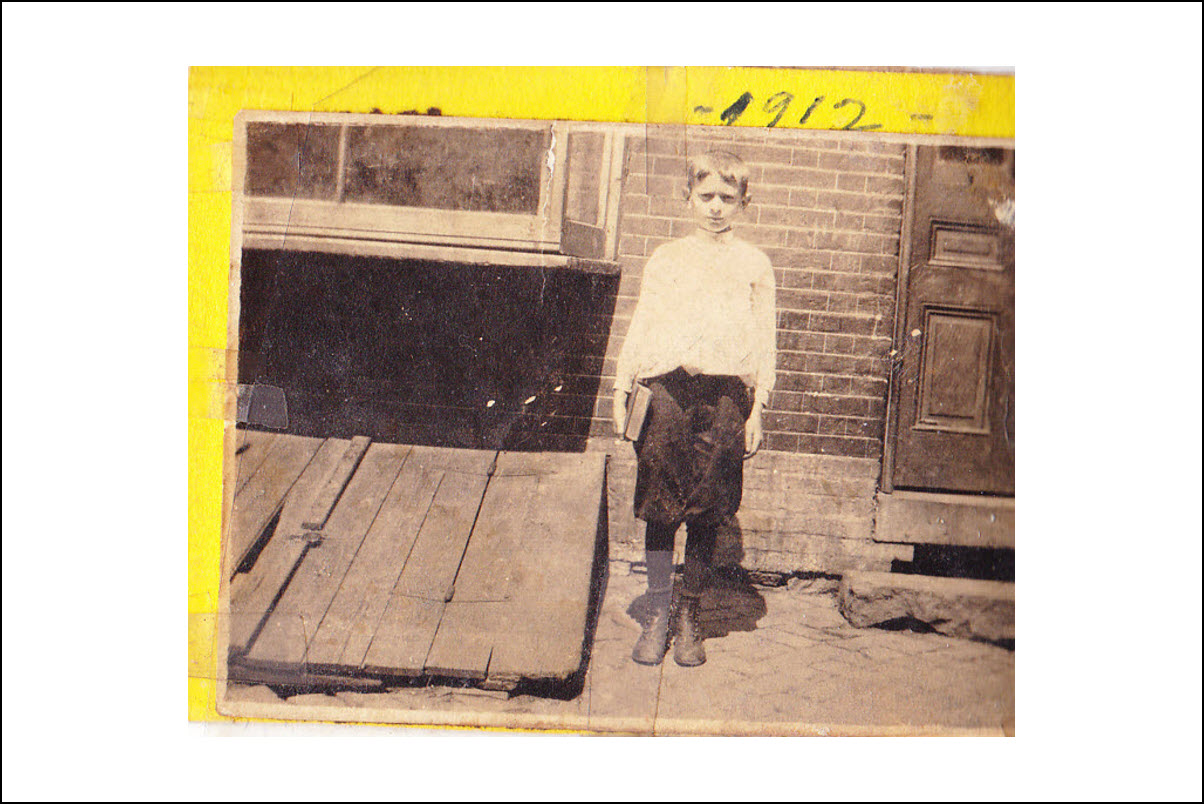 Paul H. Schwartz, Baltimore 1912. Courtesy of Ted Fishman.
Paul H. Schwartz, Baltimore 1912. Courtesy of Ted Fishman.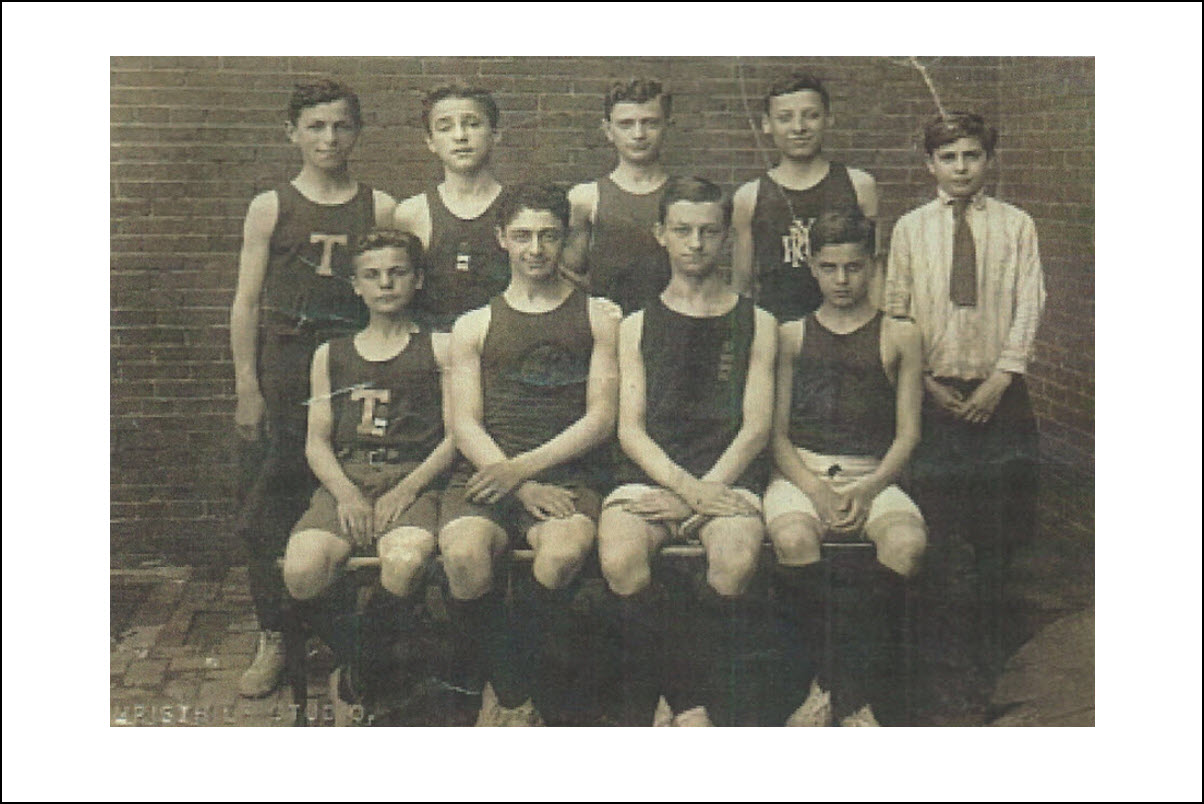 JEA Champs, Paul H. Schwartz (standing center). Courtesy of Ted Fishman.
JEA Champs, Paul H. Schwartz (standing center). Courtesy of Ted Fishman.Like the other Mlynov immigrants who arrived around this time, my grandfather's family initially piled into living quarters with their cousins just around the corner from what is now the Star-Spangled Banner House, the home where Mary Pickersgill lived when she, her daughters and an African American servant fashioned the flag that flew over Fort McHenry during the War of 1812 and inspired Francis Scott Key to write his poem.
Their location was in many ways a potent symbol of what life would be like for these new Mlynov immigrants. In 1914, two years after my grandfather's arrival, Baltimore had a massive centential celebration of that war's end, a city-wide festival in which Baltimore asserted its own symbolic importance to American patriotism and identity via the Star Spangled Banner.
My grandfather and family could very well have been present that 9th day of September 1914, at the corner of Albemarle and E. Pratt Street, when the city fixed a plaque on the wall of Mary Pickersgill's house. It would eventually be a national monument. Like the other Mlynov immigrants, his family was certainly were aware of the parades, exhibits and fireworks taking place across the city that entire week; they probably knew that Paul's first cousin, Mlynov-born, Clara Fram, was one of 6,400 school children who created a human American flag at Fort McHenry that week.
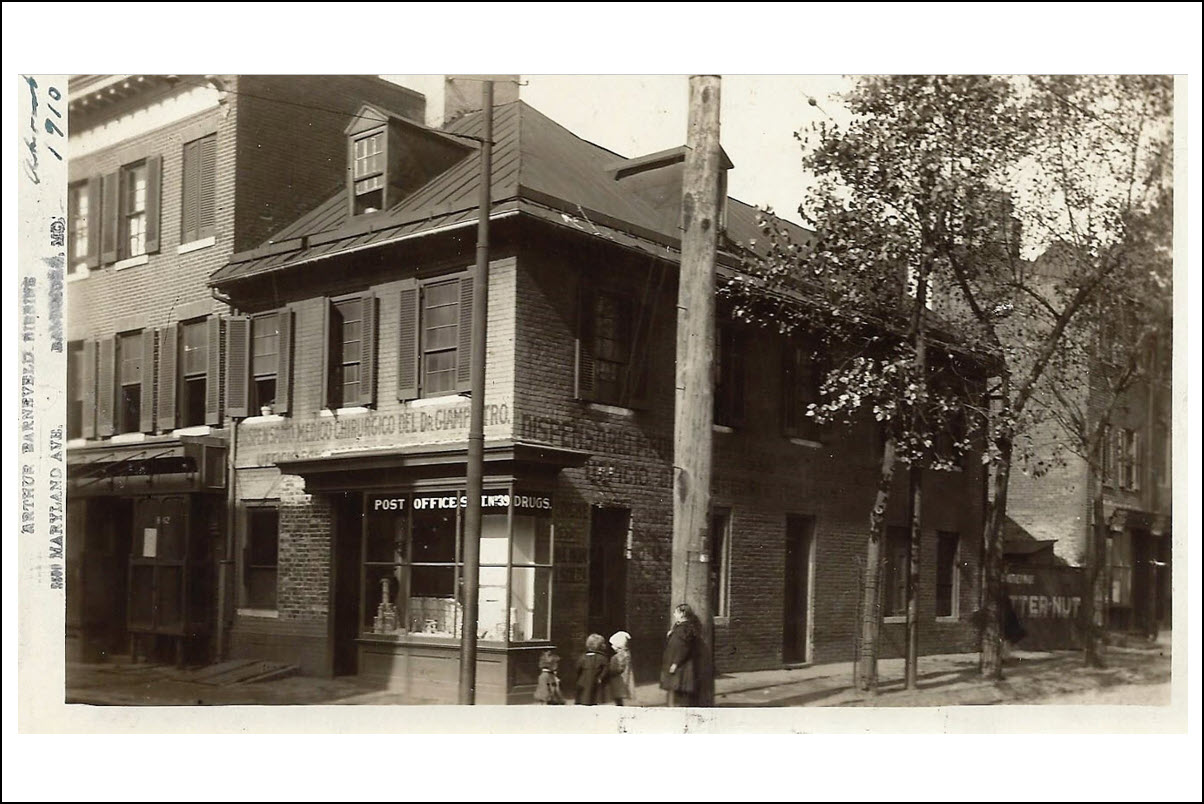 Children in front of Star-Spangled Banner Flag House in Baltimore, circa 1910. Courtesy of the Star-Spangled Banner Flag House and Museum
Children in front of Star-Spangled Banner Flag House in Baltimore, circa 1910. Courtesy of the Star-Spangled Banner Flag House and Museum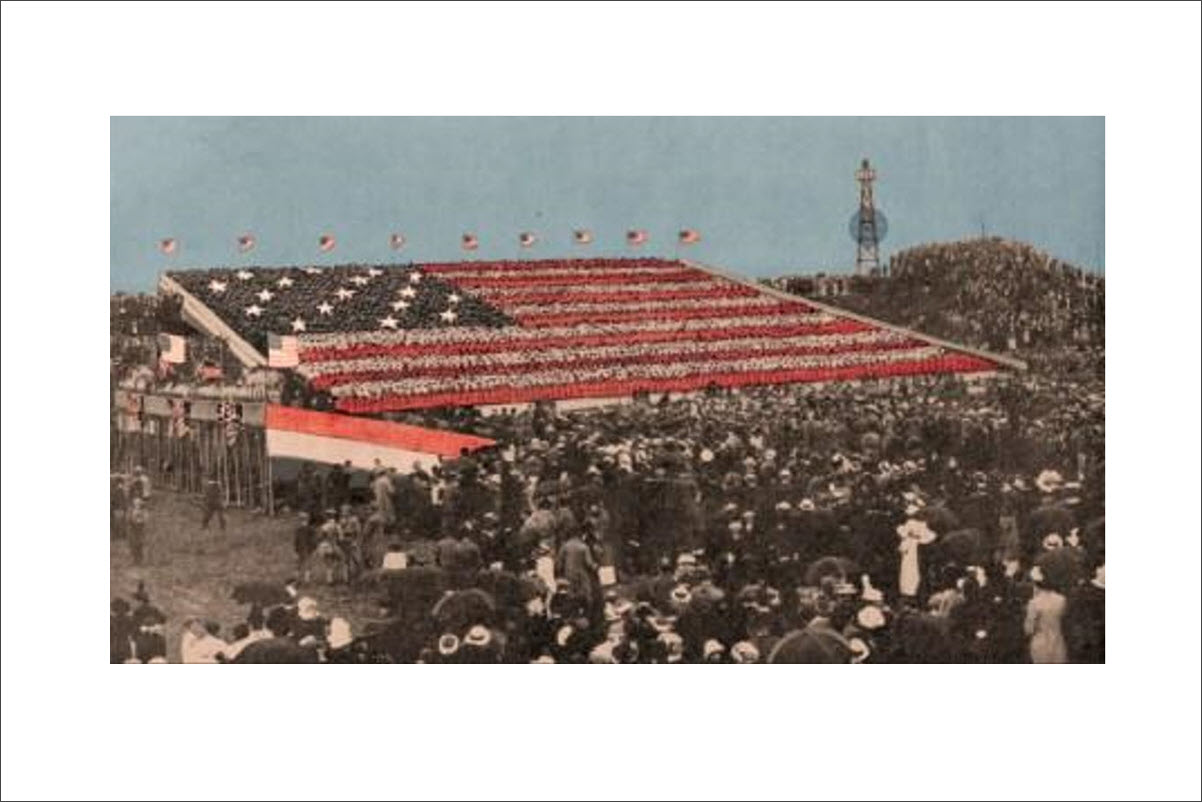 Clara Fram was among the 6,400 students who made the Human American Flag in 1914 for the Centential Celebration of the Star-Spangled Banner.[2]
Clara Fram was among the 6,400 students who made the Human American Flag in 1914 for the Centential Celebration of the Star-Spangled Banner.[2]After they got their feet under them, Paul's family moved out of the home of his Aunt Mollie Roskes, and they had their own mom and pop confectionary store, which was a family run business in East Baltimore, an area crowded with other Russian Jewish immigrants. A family photo shows Paul, as a young teenager, participating in a baseketball team sponsored by the JEA (the Jewish Education Alliance), an organization formed to help Russian immigrants Americanize and acculturate.[3] Paul and his brother Norton would eventually open their own grocery called "Schwartz Bros" in Northeast Baltimore where Jews had been prevented from settling through gentlemen's agreements by real estate agents and developers.
Since my grandfather, Paul, had arrived in Baltimore at the age of ten, he spoke English with an American accent. This was not the case with my grandmother, Pepe Shulman, who had arrived in Baltimore in 1921 after WWI. Pepe's parents had been evacuated from Mlynov during WWI and in the fallout from the War, they decided to leave and make their way to Baltimore, where they had family and friends. They left behind the families of two of their eldest daughters, only one of which survived WWII in Russia.
Though I remember my grandparents, Paul and Pepe, with great fondness from my youth, I never really had much interest in where they came from until much later. It is only in the last several years, after my own parents passed away, that I took an interest in their story. As I was taking down the photos from the walls of my parents' home, I pondered the two family photos of my grandparents as young children seated with their families from Mlynov. I could pick out my grandparents in the photos and name some of their siblings and parents, but I didn't know much more. At that point, I didn't even know the name of the shtetl from which they had come. And so I set out to learn more. This website which honors Mlynov is one product of that effort.
ACKNOWLEDGMENTS
My work stands on the shoulders of others who passed this way before me. I want to especially acknowlege here the fellow family historians who preserved photos, stories and videos of those from Mlynov and who shared those with me.
- Ted Fishman
- Julius Edlavitch
- Clara Fram
- Audrey (Goldseker) Polt
- Irene Siegel
Ted is the son of Ben Fishman and Clara Shulman, one of my father's close friends and first cousins, has been a storehouse of many photos, oral traditions and videos that have preserved much that I have learned in the course of my own research. Ted is the ultimate collector. From Ted, I have learned a great deal about the Demb, Shulman, Fishman and Schwartz families from Mlynov. Engaging with Ted and "picking his brain", sometimes on a weekly basis, has been one of the blessings of my own endeavor, not only because of his knowledge but because he tells me stories about my father. Ted's son, Saul, also made a critical contribution by digitizing a great number of photos and videos that I have leveraged in this effort.
Julius is the son of Betty (Shulman) Edlavitch and grandson of Paul (Zutelman/Settleman) and Sarah Shulman. Building on the earlier work of Ted Fishman, Julius reached out to family and pulled together the extensive Demb family tree, in the days before the Internet. His work provided the foundation for my own understanding. Julius also organized the first Demb Family Reunion in August 1992. Unfortunately, by the time I got interested in all of this, Julius was not well enough to engage with me. I am grateful to all his efforts preserving family memories.
Clara was born in Mlynov in 1902 to David and Bessie (Demb) Hurwitz. I am so grateful that in 1982 Clara sat down and wrote her memoire. The memoire is a wonderful, nostalgic account of Mlynov through the eyes of a child in the period from 1904–1909. She preserved some of the only first hand accounts of the period. In addition, Clara's paternal grandparents were Getzel and Ida (Rivitz), the first pioneers to Baltimore; her account has been invaluable in reconstructing the extensive migration from Mlynov to Baltimore. Clara's maternal grandparents were Israel Jacob and Rivkah (Gruber) Demb and her memories of them and visits to some of her first cousins are the only accounts of the large Demb family in that period.
As I tried to understand my family's story, I found that I had to understand the story of other Mlynov immigrants to Baltimore. Audrey (Goldseker) Polt, the daughter of Sonny David Goldseker, provided me extensive help by sharing with me her collection of photos and stories that she had collected over the years, not to mention ongoing encouragement of efforts. I met Audrey only serendipitously after tracking down one of my third cousins, Carol Engelman, who lived across the street from Audrey.
Many photos and narratives that came into my hands via other people were saved originally by Irene Siegel who took an avid interest in Mlynov and the stories of the Goldseker and Fishman families. Irene is the daughter of David Fishman and Eta (Goldseker) Fishman. I am grateful to Irene for all the effort she made saving photos and documenting stories and to her family who have been supportive of my efforts.
NOTES
[1] Second row seated (right to left): Pepe's mother, Pearl Demb, Pearl's parents, Israel Jacob and Rivkah (Gruber) Demb, Pearl's husband Tsodik Shulman, their son-in-law, Saul Meiler. Back row (left to right): Tsodik and Pearl's daughter, Nachuma (Shulman) Meiler, son "Ertz" (Harry) Shulman, daughter Liza (Shulman) Koszhusner, Liza's husband Shia Koszhusner, Tsodik and Pearl's son Simon Shulman. Front row (left to right): daughters Sarah Shulman, Pepe Shulman, Clara Shulman and baby, granddaughter, Tamara Meiler. ↩
[2] Fram, "My Story" p. 4–5. The photo of the human flag was posted by Richard Gorelick. ↩
[3] Based on an article published originally about JEA in the magazine Generations by the Jewish Museum of Maryland (the article has since been removed from the web site). ↩.
***
Compiled by Howard I. Schwartz
Updated: August 2024
Copyright © 2021 Howard I. Schwartz, PhD
Webpage Design by Howard I. Schwartz
Want to search for more information: JewishGen Home Page
Want to look at other Town pages: KehilaLinks Home Page
This page is hosted at no cost to the public by JewishGen, Inc., a non-profit corporation. If it has been useful to you, or if you are moved by the effort to preserve the memory of our lost communities, your JewishGen-erosity would be deeply appreciated.
- History
